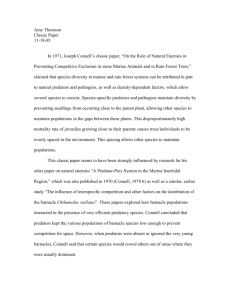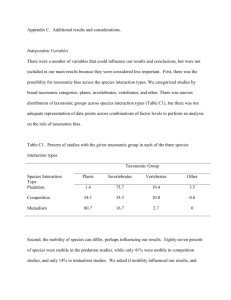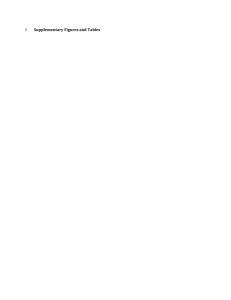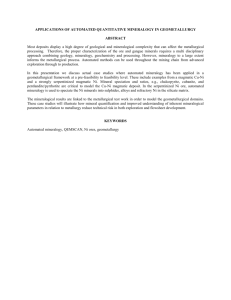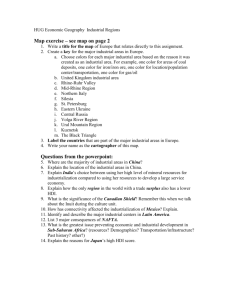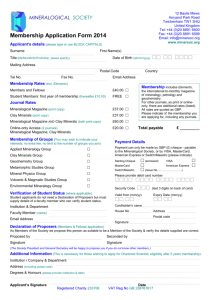Johannes Menge - Professional Historians Association (South
advertisement
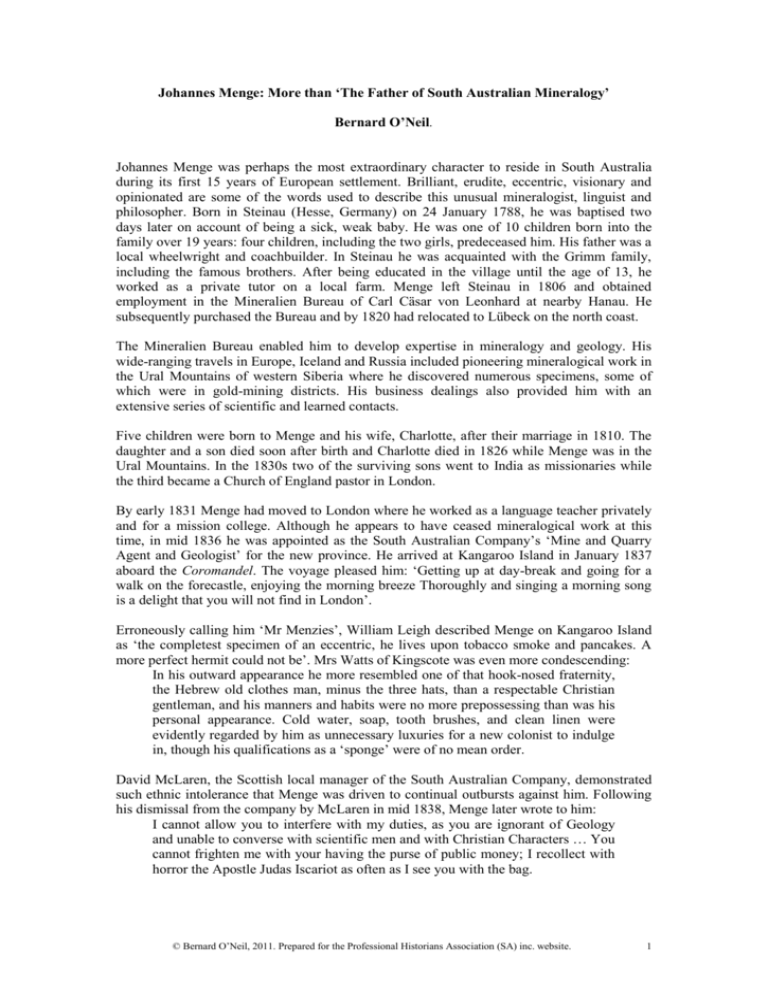
Johannes Menge: More than ‘The Father of South Australian Mineralogy’ Bernard O’Neil. Johannes Menge was perhaps the most extraordinary character to reside in South Australia during its first 15 years of European settlement. Brilliant, erudite, eccentric, visionary and opinionated are some of the words used to describe this unusual mineralogist, linguist and philosopher. Born in Steinau (Hesse, Germany) on 24 January 1788, he was baptised two days later on account of being a sick, weak baby. He was one of 10 children born into the family over 19 years: four children, including the two girls, predeceased him. His father was a local wheelwright and coachbuilder. In Steinau he was acquainted with the Grimm family, including the famous brothers. After being educated in the village until the age of 13, he worked as a private tutor on a local farm. Menge left Steinau in 1806 and obtained employment in the Mineralien Bureau of Carl Cäsar von Leonhard at nearby Hanau. He subsequently purchased the Bureau and by 1820 had relocated to Lübeck on the north coast. The Mineralien Bureau enabled him to develop expertise in mineralogy and geology. His wide-ranging travels in Europe, Iceland and Russia included pioneering mineralogical work in the Ural Mountains of western Siberia where he discovered numerous specimens, some of which were in gold-mining districts. His business dealings also provided him with an extensive series of scientific and learned contacts. Five children were born to Menge and his wife, Charlotte, after their marriage in 1810. The daughter and a son died soon after birth and Charlotte died in 1826 while Menge was in the Ural Mountains. In the 1830s two of the surviving sons went to India as missionaries while the third became a Church of England pastor in London. By early 1831 Menge had moved to London where he worked as a language teacher privately and for a mission college. Although he appears to have ceased mineralogical work at this time, in mid 1836 he was appointed as the South Australian Company’s ‘Mine and Quarry Agent and Geologist’ for the new province. He arrived at Kangaroo Island in January 1837 aboard the Coromandel. The voyage pleased him: ‘Getting up at day-break and going for a walk on the forecastle, enjoying the morning breeze Thoroughly and singing a morning song is a delight that you will not find in London’. Erroneously calling him ‘Mr Menzies’, William Leigh described Menge on Kangaroo Island as ‘the completest specimen of an eccentric, he lives upon tobacco smoke and pancakes. A more perfect hermit could not be’. Mrs Watts of Kingscote was even more condescending: In his outward appearance he more resembled one of that hook-nosed fraternity, the Hebrew old clothes man, minus the three hats, than a respectable Christian gentleman, and his manners and habits were no more prepossessing than was his personal appearance. Cold water, soap, tooth brushes, and clean linen were evidently regarded by him as unnecessary luxuries for a new colonist to indulge in, though his qualifications as a ‘sponge’ were of no mean order. David McLaren, the Scottish local manager of the South Australian Company, demonstrated such ethnic intolerance that Menge was driven to continual outbursts against him. Following his dismissal from the company by McLaren in mid 1838, Menge later wrote to him: I cannot allow you to interfere with my duties, as you are ignorant of Geology and unable to converse with scientific men and with Christian Characters … You cannot frighten me with your having the purse of public money; I recollect with horror the Apostle Judas Iscariot as often as I see you with the bag. © Bernard O’Neil, 2011. Prepared for the Professional Historians Association (SA) inc. website. 1 Moving to the mainland, Menge then began working for the South Australian Company’s director in London, George Fife Angas, on a private basis. He based himself at Pastor Augustus Kavel’s German village of Klemzig. From there a week before Easter in 1839, he and Pastor Clamor Wilhelm Schürmann set off for the junction of the Darling and Murray rivers where Angas wanted to place the Germans and the Aborigines of South Australia. They first went to the Para River and then camped along the Murray, only to turn back when Schürmann tired of the trek across the ‘desert’. Their return journey to the Para revealed to Menge an area of land which he described to Angas as ‘the cream, the whole cream and nothing but the cream of South Australia’. He called this ‘New Silesia’ and convinced Charles Flaxman (Angas’s agent in the colony) and Kavel that this was the future home of the German migrants. In addition, the land was very well suited to viticulture said Menge with incisive foresight: ‘I feel happy to repeat to you my convictions respecting your surveys that your land is and will prove the kernel of this province! … You may confidently put vines round Flaxman Valley, the Rhine Valley … for luxurious harvests and I am satisfied that New Silesia will furnish the province with such a quantity of wine that we shall drink it as cheap as in Cape Town’. Based upon his forceful testimony, Flaxman speculatively purchased 28 000 acres for Angas. Thus began the famous wine-producing area known as the Barossa Valley. Now held in higher regard, Governor Gawler and his wife invited Menge to a levee and drawing room with other prominent colonists in May 1839. This was also the occasion of the first Queen’s Birthday dinner given to Aborigines after which several German settlers took an oath of allegiance to Queen Victoria. The leading Germans, Kavel and Menge, were the first two signatories. Later that year Menge was naturalised as a British subject. Menge settled in New Silesia on an island which he had created by diverting the Moorooroo Creek (now Jacob Creek) into a watercourse leading to the creek’s junction with the North Para River. The creek flowed past a natural cave which occasionally provided him with temporary shelter. He planted crops on ‘Menge’s Island’ to experiment with the land: the vegetables he grew were sometimes sold to settlers nearby and in Gawler and Adelaide. In a report to Angas in 1840 Menge described the fertility of parts of New Silesia and its possibilities: ‘In general the country is invaluable and will repay any amount of capital applied to the cultivation thereof’. His mineralogical rambles in New Silesia saw him discover opal near Angaston in 1839, collect minerals for sale and, later, assist German potters in their quest for clay and sand for pottery work. In 1840 he commented: ‘But all the minerals I have found hitherto, of which I may offer collections of 200 specimens, are of a mere introductory nature to the treasures hidden within the ranges of this province … I have in all my voyages and travels … through 25 years, not met with a range of hills so rich in minerals as the range from Adelaide up to Light’s Pass … no country in the world is so well adapted for promoting the science of geology and mineralogy’. Indeed, his extensive discoveries of rocks and minerals allegedly included gold, emeralds and diamonds! Some of his specimens formed part of South Australia’s display at the Great Exhibition of 1851 at London’s Crystal Palace. Although Menge’s explorations after he left his island early in 1842 took him north towards the Flinders Ranges, his linguistic pursuits again came to the fore. Between 1845 and 1850 he conducted language classes privately and for the German School Association in Adelaide and he taught Hebrew for almost a year at the Lutheran Theological College in Lobethal. In this period Menge began preparing comparative tables of grammar for publication. In 1848 he was the first editor of the first bi-lingual newspaper in Australia, Die Deutsche Post für die Australischen Colonien (The German-Australian Post), but it only lasted for 16 issues. © Bernard O’Neil, 2011. Prepared for the Professional Historians Association (SA) inc. website. 2 Though often portrayed as a drifter and a loner, Menge was a friendly, harmless soul of high intelligence who considered he was on a lifelong religious or mystical journey to a higher authority. Early in 1852 he succumbed to the fever of the gold rush. He was placed in charge of a party of 50 German miners who went from Adelaide to work the diggings at Castlemaine in Victoria. They deserted him when he pursued his desire to tunnel for gold in order to find enough gold to establish a mission college in China. (He had predicted in 1836 that Australia’s future lay in the Asian region.) His quest remained a dream for he died in mid October 1852 and was buried in an unmarked grave at Forest Creek. Sites and memorials Menge named many places in the Barossa Valley but few names have survived: two are Kaiserstuhl (after a similar hill in the Black Forest region of southwest Germany) and Carrara Hill (after the hill in a marble region of Italy: it was near this hill that he found ‘common’ opal). Rivers such as the Rhine have been renamed. The Tanunda By-Pass Road was renamed Menge Road in 1982: there has long been a Johannes Menge Strasse in Steinau. Plaques in honour of Menge are in the Orlando Wines cellars at Rowland Flat and on the Pioneer Avenue of Trees at the entrance to the Barossa Valley Resort and the Tanunda Golf Club. He is featured on the memorial wall in the Pioneer Cemetery in Klemzig and on a monument in the Institute of Mineralogy in Miass in the southern Ural Mountains, Russia. Brief accounts of Menge’s life are in the Australian Dictionary of Biography, Allgemeine Deutsche Biographie and Neue Deutsche Biographie. © Bernard O’Neil, 2011. Prepared for the Professional Historians Association (SA) inc. website. 3
